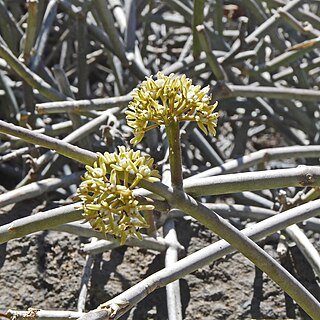
Santo Antão is the westernmost island of Cape Verde. At 785 km2 (303 sq mi), it is the largest of the Barlavento Islands group, and the second largest island of Cape Verde. The nearest island is São Vicente to the southeast, separated by the sea channel Canal de São Vicente. Its population was 38,200 in mid 2019, making it the fourth most populous island of Cape Verde after Santiago, São Vicente and Sal. Its largest city is Porto Novo on the south coast.

Thomas Vernon Wollaston FLS was a prominent English entomologist and malacologist, becoming especially known for his studies of Coleoptera inhabiting several North Atlantic archipelagoes. He was well-placed socially. His religious beliefs effectively prevented him from supporting Charles Darwin's theories after 1859, but Darwin remained a close friend. Wollaston supported the theory that continental lands had once extended outward farther to encompass some of the island groups he studied.

The wildlife of Cape Verde is spread over its archipelago of ten islands and three islets, which all have parks under their jurisdiction by decree promulgated by the Cape Verde government. Located off the west coast of Africa, the total land area of the island nation is 4,564 square kilometres (1,762 sq mi). The wildlife consists of many tropical dry forest and shrub land, endemic flora and fauna, and rare breeding seabirds and plants, which are unique to this group of islands.
Bandeirenica caboverda, locally known in Cape Verde as "mil-pés", is a species of millipedes of the family Odontopygidae. It is endemic to Cape Verde, where it occurs in the islands of Santo Antão and São Vicente. First described in 1987 as Spinotarsus caboverdus, it was placed in the genus Bandeirenica in 2000.

Silvanidae, "silvan flat bark beetles", is a family of beetles in the superfamily Cucujoidea, consisting of 58 described genera and about 500 described species. The family is represented on all continents except Antarctica, and is most diverse at both the generic and species levels in the Old World tropics.

Pensus is a genus of beetles in the family Silvanidae. A member of the subfamily Silvaninae, Pensus contains two species, Pensus gilae (Casey) and Pensus guatemalenus (Sharp), with a combined range of the southwestern United States to Guatemala.

Airaphilus is a genus of beetles in the family Silvanidae, containing the following species:

Silvanus is a genus of beetles in the family Silvanidae, containing the following species:

Euphorbia tuckeyana is a species of flowering plants of the family Euphorbiaceae. The species is endemic to Cape Verde. The species is named after James Hingston Tuckey. Its local name is tortolho. The plants are used for tanning hides.

Echium stenosiphon is a plant species of the family Boraginaceae. The species is endemic to Cape Verde. Its local name is língua-de-vaca, a name that may also refer to the related species Echium vulcanorum and Echium hypertropicum. The plant is used in traditional medicinal for a cough syrup.

Echium vulcanorum is a species of flowering plants of the family Boraginaceae. The species is endemic to Cape Verde. It is listed as an endangered plant by the IUCN. The species was first described in 1935 by Auguste Chevalier. Its local name is língua-de-vaca, a name that may also refer to the related species Echium hypertropicum and Echium stenosiphon. The oil of its seeds contains γ-linolenic acid, and is used for medicinal and dietary purposes.
Limonium braunii is a species of flowering plants of the family Plumbaginaceae. The species is endemic to Cape Verde. It is listed as an endangered plant by the IUCN. The species was first described by the German Carl August Bolle as Statice braunii and was placed in the genus Limonium by the French Auguste Chevalier in 1935. Its local name is carqueja, a name that may also refer to the related species Limonium brunneri and Limonium jovibarba.

Sarcostemma daltonii is a species of flowering plants of the family Apocynaceae. The species is endemic to Cape Verde. The specific name refers to Joseph Dalton Hooker. The species was named by Joseph Decaisne in 1849. Its local name is gestiba. The plant is used in traditional medicine to relieve and treat dental problems.

Tamarix senegalensis is a species of flowering plants of the Tamaricaceae family. It is a tree or twiggy shrub, that grows in saline soil, sandy desert and sea-shore.
Anaspis brevicornis is a species of beetles of the family Scraptiidae. It is endemic to Cape Verde, where it occurs on the islands of Santo Antão and Fogo. The species was described by Thomas Vernon Wollaston in 1867.

Periploca laevigata is a species of flowering plant in the family Apocynaceae, native to the Canary Islands, the Savage Islands and Cape Verde.
Silvanus planatus is a species of silvanid flat bark beetle in the family Silvanidae. It is found in North America and Oceania.
Silvanus muticus is a species of silvanid flat bark beetle in the family Silvanidae. It is found in Central America and North America.
Silvanus nitidulus is a species of silvanid flat bark beetle in the family Silvanidae. It is found in North America.

Silvanus bidentatus, known generally as the flat bark beetle or two-toothed grain beetle, is a species of silvanid flat bark beetle in the family Silvanidae. It is found in North America, Oceania, and Europe.













